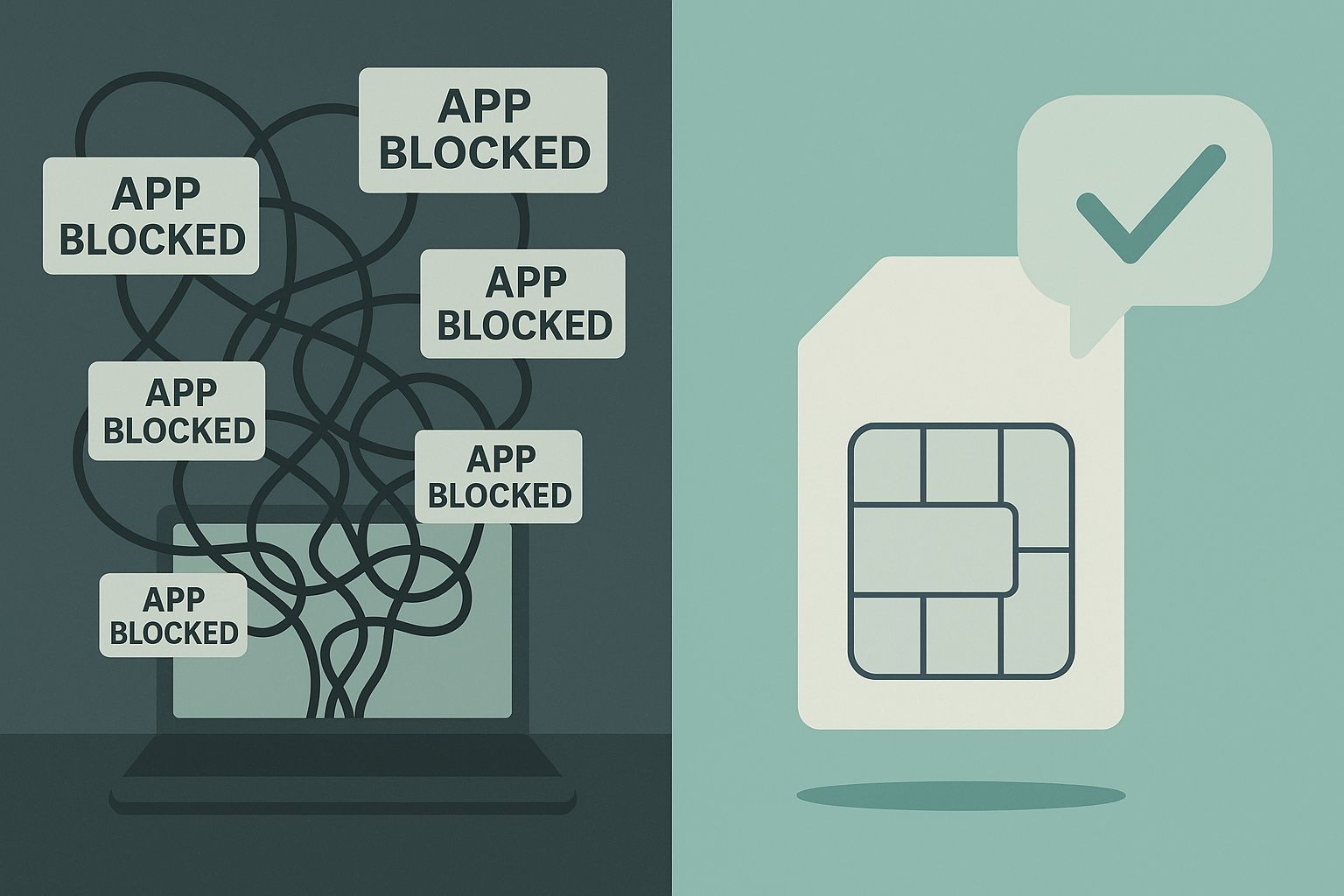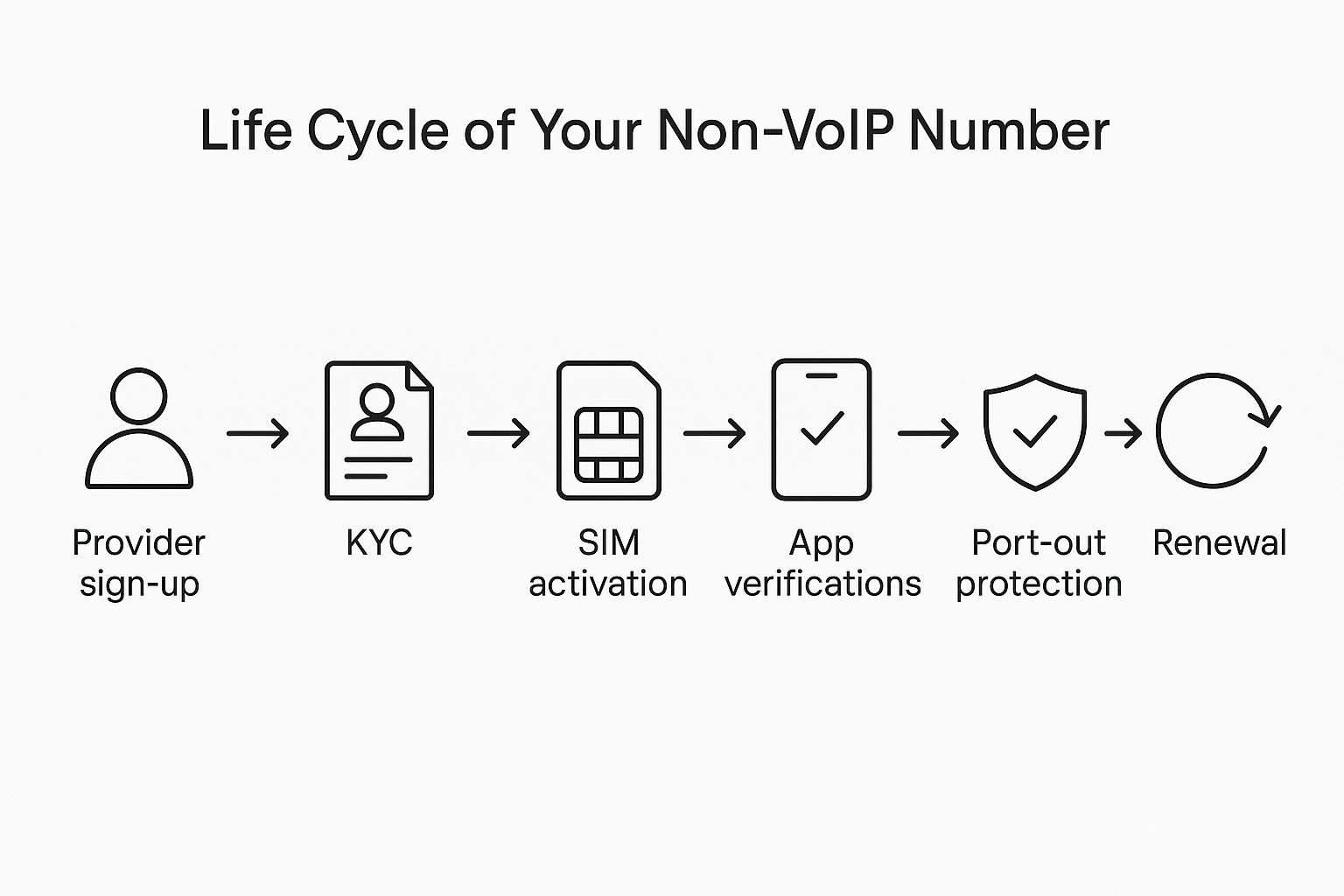You, me, and the great SMS mystery
Ever tried to sign up for PayPal or WhatsApp only to watch their “Verify your phone” screen spin forever? Nine times out of ten it’s because the platform sniffs out that your number is VoIP virtual, easily recycled, and at higher risk of fraud. Apps want the real thing: a SIM anchored, carrier issued non VoIP number.
So if you’re googling “non VoIP numbers free trial” or “buy US non VoIP number,” pull up a chair. I’ll walk you through:
- How non VoIP lines differ from the alphabet soup of fixed and non fixed VoIP,
- The quickest way to road test a provider in under ten minutes,
- hidden fees and compliance traps the FCC started cracking down on in late 2024, and
- a security checklist that keeps SIM swap crooks at bay.

Why SIM based still wins the trust game
Voice engineers call the public switched telephone network the PSTN basically the old school mesh of cell towers, fiber, and copper that physically links a number to a geographical area. A non VoIP number lives on that network. Because its ownership and billing address can be verified, banks and gig work apps see it as “high assurance.”
Contrast that with:
- Fixed VoIP – a virtual number mapped to a service address (often a desk phone in an office).
- Non fixed VoIP – an internet only number that might point to anywhere and anyone.
The traceability gap explains why the CTIA’s 2023 Messaging Principles push businesses to use verified, carrier assigned numbers for A2P traffic. In plain English: if your SMS matters, use a number platforms can trace back to an actual subscriber record.
Your ten minute road test
You don’t need to sign a year long contract just to see if a provider’s claims hold water. Do this quick sprint instead:
1. Sign up and clear KYC. Legitimate carriers will ask for an ID or business EIN. If they don’t, that’s a red flag.
2. Claim a number in your target country. Make sure the area code aligns with your user base. LatAm fintechs, for instance, sometimes need both US and MX ranges.
3. Send two SMS tests. One to a mainstream destination (e.g., a personal T Mobile phone) and one to a high scrutiny service like PayPal. Note delivery time and whether the verification code arrives at all.
4. Check the delivery receipts dashboard. Serious vendors expose latency and carrier hand off logs so you can spot bottlenecks.
5. Call the number from a landline. You’re listening for dead air or endless ring signs the provider is stretching capacity.
If any step feels opaque, walk away. There are dozens of providers; transparency is your filter.
Country and platform compatibility cheat sheet
| Destination service | Works with most US non VoIP? | Gotchas to know up front |
|---|---|---|
| WhatsApp Business | Yes, but must remove from previous account first | Number can’t already live on personal WhatsApp |
| Telegram | Generally yes | Requires SMS and voice fallback in some regions |
| PayPal & Venmo | Yes if carrier grade | Accounts with past VoIP history may need manual review |
| Amazon Seller | yes | Amazon autoflags numbers recycled within 30 days |
| Government portals (IRS, SSA) | Mixed results outside the US | Many block non US issuer identification codes |
Hidden fees and compliance tripwires
- E911 surcharges – US carriers are legally required to route emergency calls. If you’re outside the States, you might still see a regulatory fee on invoices.
- Directory listing (CNAM) look ups – Want your caller ID to say “ACME Inc”? Some providers upsell that at $0.003 per dip.
- Overage SMS rates – The headline price might be $0.008 per outbound text, but overages can jump to $0.012 once you cross a quota.
- Autorenewed number rental – Numbers often renew every 30 days. Miss the cutoff and the SIM may be reassigned undoing any verifications tied to it.
- FCC robocall blocking rules – In 2024 the Commission tightened requirements on call authentication; providers failing SHAKEN/STIR can get your calls dropped at the ingress carrier.
Porting or migrating? Read this first
Moving from Google Voice or TextNow to a carrier grade line sounds simple until you hit:
- Number aging policies. Major carriers hold a ported out number for 45 days before reissuing. Plan downtime accordingly.
- SMS routing overlaps. During porting, some messages may still land on the old app while voice rings on the new SIM. Mitigate by setting forwarding rules inside the legacy VoIP app.
- Unlock fees. Certain VoIP apps charge $3–$5 to hand over the number. Budget for it; disputing the charge can drag the process by weeks.
Security checklist before you add the number to mission critical systems
1. Account level PIN – Ask your carrier to place a port out PIN; this stops social engineering thieves.
2. SIM lock with PUK code – Most modern phones support a SIM PIN that renders the chip useless if stolen.
3. Do Not Port registry – US carriers participate in a line blocking database; enlist your number.
4. 10DLC registration for messaging at scale – If you’re sending more than ~3 000 SMS/day, register your brand and campaign. It’ll save deliverability headaches and fines outlined in CTIA rules.

Decision tree: solo founder or enterprise team?
If you’re a one person SaaS side gig Go prepaid, month to month. Prioritize easy online dashboards over bulk discounts. You’ll value agility when you pivot markets.
If you manage an ops team with customer support workflows Look for pooled messaging plans, API access, and service level agreements. Downtime penalties and 24/7 support hotlines matter more than a one cent delta in SMS pricing.
FAQs
1. Does a free trial mean all SMS are free?
Usually not. Trials often waive the number rental fee but still bill per text. Read the footnotes.
2. Can non US residents buy a US non VoIP number?
Yes, but you’ll need an ID scan and sometimes an EIN or ITIN to satisfy the carrier’s “know your customer” rules.
3. How fast can I swap a lost SIM?
Most Tier 1 carriers overnight a replacement after an ID check. Budget 24–48 hours of downtime.
4. Are non VoIP numbers immune to robocalls?
No, but FCC call authentication requirements (SHAKEN/STIR) help legit numbers get through while many spoofed calls are blocked.
Conclusion
We covered a lot, but the gist is simple: a real SIM beats a virtual workaround when reputation and reach matter. Run the ten minute test, scan for hidden surcharges, lock your SIM against port outs, and you’ll ride above 90 % deliverability, something the FCC and CTIA both want to see.
Once your line is humming, consider how you’ll use it day to day. Our team at Superu pairs high assurance numbers with AI voice agents that can verify users, schedule appointments, or upsell all without the late night engineering sprint. If that sounds like one less headache on your plate, you know where to find me.
Ready to offload calls? Book a SuperU AI voice agent demo.
Start for Free – Create Your First Voice Agent in Minutes


